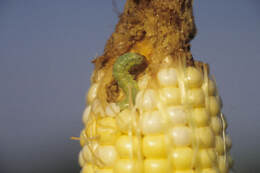
Description
The adult sweet corn earworm moth has a wingspan of 1 to 1 ½-inches. The forewings of the male are light yellowish-green while the female moth has yellowish or pinkish brown forewings. There is a dark spot in the center of the wings. Newly hatched eggs are white and dome-shaped but the color changes to a reddish-brown. Larvae range in color including yellow, green, red and brownish-black. The head is brown and tiny hairs cover the body.
Life Cycle
Sweet Corn Earworm overwinters in the soil. Adults emerge from underground and females lay eggs on the fresh silk of corn plants. Eggs hatch within two to five days. The larvae begin eating the silk and then move to the ear. Larvae reach maturity in 14 to 16 days, drop to the ground and pupate, beginning the next generation.
Damage
Earworms initially feed on corn silks, but move to feeding on the kernels. Damage is typically restricted to the top 1 to 1 ½-inches of the cob. There is usually only one earworm feeding per ear because they will cannibalize others.
Control
Once the earworm has reached the ear, control is futile. The shucks serve as a protective barrier for the worm making pesticides ineffective. It is important to monitor the area for adult earworms and treat the crop every few days while new silks are growing. As the adults lay eggs the larvae will feed on the treated silks and die before making it to the ear. Insecticides are only needed the first two weeks of silking as that is the busy feeding time for the larvae.
Homeowners can use cyfluthrin (Baythroid) or spinosad (Captain Jack's Dead Bug Brew; Natural Guard Spinosad, Monterey Garden Insect Spray). Spinosad is an organic product. Commercial growers have additional choices including zeta-cypermethrin (Mustang Max), bifenthrin+zeta-cypermethrin (Hero), spinetoram (Radiant) and flubendiamide (Belt). (Cynthia Domenghini)
 RSS Feed
RSS Feed
